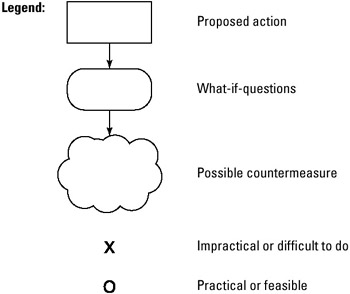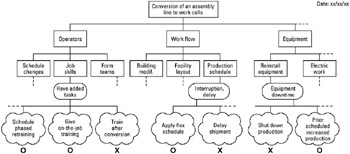Tool 148: Process Decision Program Chart (PDPC)
| AKA | N/A |
| Classification | Planning/Presenting (PP) |
Tool description
The process decision program chart (PDPC) is a contingency planning tool used to assist in establishing an implementation action plan for a complex project that has a high degree of uncertainty for successful and timely completion. This tool, which uses a very structured approach, identifies plan activities, asks what-if questions to uncover potential problem areas, and develops countermeasures for any problems that might occur.
Typical application
-
To perform contingency planning prior to implementing a complex activity problem or solution with high uncertainty.
-
To determine possible countermeasures in order to minimize any problems that may surface when an unfamiliar activity is performed.
-
To anticipate problems and consider consequences due to errors or gaps in planning.
Problem-solving phase
| Select and define problem or opportunity | |
| → | Identify and analyze causes or potential change |
| → | Develop and plan possible solutions or change |
| Implement and evaluate solution or change | |
| Measure and report solution or change results | |
| Recognize and reward team efforts |
Typically used by
| Research/statistics | |
| 3 | Creativity/innovation |
| Engineering | |
| 2 | Project management |
| Manufacturing | |
| Marketing/sales | |
| Administration/documentation | |
| 4 | Servicing/support |
| Customer/quality metrics | |
| 1 | Change management |
before
-
Tree Diagram
-
Problem Specification
-
Matrix Diagram
-
Weighted Voting
-
Process Analysis
after
-
Countermeasures Matrix
-
Starbursting
-
Solution Matrix
-
Action Plan
-
Variance Analysis
Notes and key points

Step-by-step procedure
-
STEP 1 The team refers to a previously completed data collection and analysis. This data source can be a tree diagram, matrix diagram, a problem specification, or some other tool reference.
-
STEP 2 The next step is to construct a PDPC chart as outlined in the example Conversion of an Assembly Line to Work Cells.
-
STEP 3 First, list the project goal, followed by a lower level of primary activities detailed further into required tasks. Ensure that all activities have been considered from the data source.
-
STEP 4 For each task or requirement, ask what-ifs. See example What if there is an interruption in production output? What if there is equipment downtime?
-
STEP 5 For every what-if, consider what countermeasures can be taken. Connect what-ifs and countermeasures to the tasks to complete the chart. Designate countermeasures as practical and feasible = 0, or impractical and difficult = X.
-
STEP 6 Review the chart, make revisions if needed, and provide date of issue.
Example of tool application

EAN: 2147483647
Pages: 326